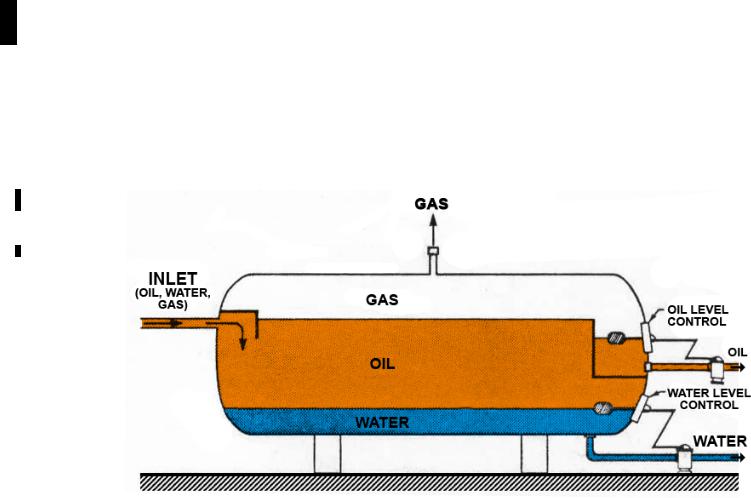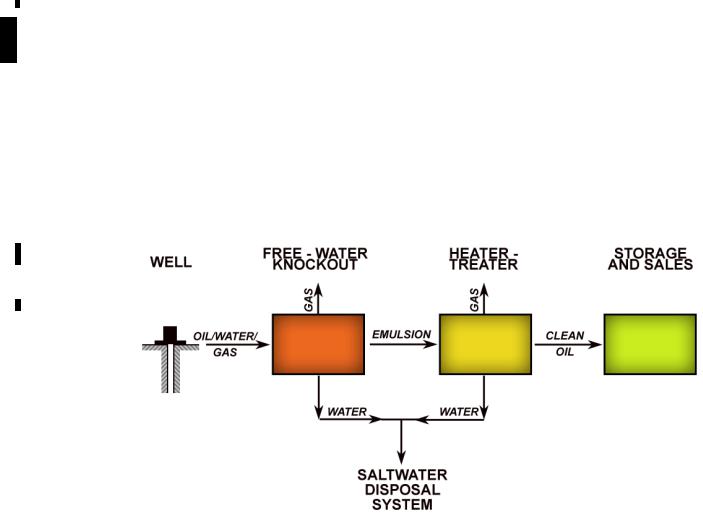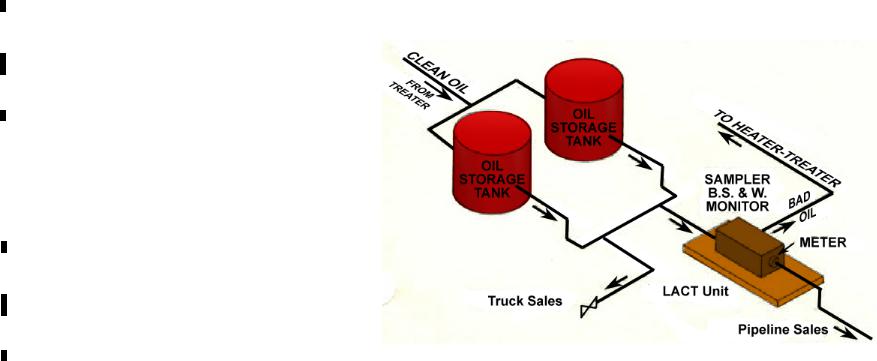
Chapter_7-OCW
.pdf
Free Water Knockout
The oil and water outlets are controlled by level controlled valves, which prevent the vessel from draining completely and keep the gas trapped in the top of the vessel.
Commonly used for low pressure wells and can be used to handle high volumes of fluid.

Vertical Free Water Knockout

Heater-Treater
Also called emulsion treater, used to separate oil and water emulsions.
Similar to free-water knockout but the treater has heating capability with the inclusion of fire tubes.
 The combustion of the gas within the fire tubes is used to heat oil and water emulsion.
The combustion of the gas within the fire tubes is used to heat oil and water emulsion.

Heater-Treater
As the oil and water mixture grows hotter, the emulsion breaks and forms into clean oil and clean water.
 The water is removed from the bottom and sent to the water disposal system.
The water is removed from the bottom and sent to the water disposal system.
The clean oil is drawn off the center of the vessel and sent to the oil storage tanks for sale.
 Any natural gas in the oil-water emulsion exits at the top of the heater-treater.
Any natural gas in the oil-water emulsion exits at the top of the heater-treater.

Combinations
A typical combination of equipment is shown below.
Oil, water and gas produced as a mixture sent into free-water knockout.
The remaining oil and water emulsion leaves the free-water knockout and is transferred to the heater-treater.
 On an offshore platform, a high pressure separator often will be used instead of the free-water knockout.
On an offshore platform, a high pressure separator often will be used instead of the free-water knockout.
Surface facilities for typical oil well

Typical Oil Treating Facility

Oil Storage and Sales - Onshore
At a typical facility, sufficient storage is provided to accommodate oil from two to three days of production.

Oil may be withdrawn from the tank and sold by truck/tanker or through pipeline to the refinery.
Lease Automatic Custody Transfer measures the
volume of oil as it passes into the pipeline. It also
measures the BS&W content.

Oil Storage and Sales - Offshore
Offshore production platforms can sometimes be equipped with oil storage equipment if the platform is located in shallow water.
 The clean oil can be sold through a pipeline extending from the platform along the sea floor to the land.
The clean oil can be sold through a pipeline extending from the platform along the sea floor to the land.

Oil Storage and Sales - Offshore
In deep water operation, oil is shipped through a pipeline along the sea floor to another storage platform in shallow water.
 Sometimes, storage platform in not necessary and the oil is shipped directly into the sales line.
Sometimes, storage platform in not necessary and the oil is shipped directly into the sales line.
 For remote oilfield, deepwater locations and small oilfield, where seabed pipelines are not cost effective, the use of FPSO is a good option.
For remote oilfield, deepwater locations and small oilfield, where seabed pipelines are not cost effective, the use of FPSO is a good option.
 Oil is stored in the FPSO and will be offloaded onto tanker.
Oil is stored in the FPSO and will be offloaded onto tanker.

Saltwater Disposal
To prevent environmental pollution, the water produced must be re-injected into the ground, often into the same rock from which it was drawn.
 The water is taken from the oil processing equipments and usually sent to a storage tank until a sufficient volume has been accumulated.
The water is taken from the oil processing equipments and usually sent to a storage tank until a sufficient volume has been accumulated.
 Often in offshore operation, the salt water from the wells can be disposed of into the sea itself.
Often in offshore operation, the salt water from the wells can be disposed of into the sea itself.
 However, the water must first be sent through several
However, the water must first be sent through several  cleaning devices which remove any traces of oil.
cleaning devices which remove any traces of oil.
